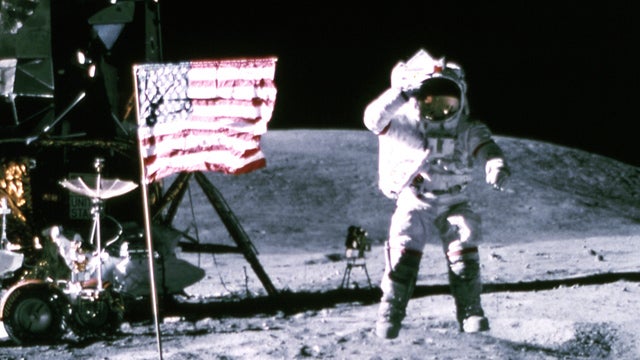RUSH: We are recognizing this week one of the most phenomenal achievements in world history, and that is America’s trip to the Moon that landed two astronauts on it. The 50th anniversary launch was yesterday. And it was kind of interesting – (interruption) What? Oh, yeah, it did happen. Don’t sidetrack me on these kooks that think it was all put together on a sound stage.
Yesterday on YouTube, CBS reran in its entirety the launch coverage with Walter Cronkite on the scene down at Cape Canaveral. It was fascinating to read a bunch of tech bloggers who were not even born. They were not even thoughts in 1969, going back and looking at news coverage from that era, they are all fascinated by it.
But I ran across something that will blow your mind. If you were alive and paying attention to the space program back then, the space program itself had its own PR firm, had its own PR agency within NASA. And they had spokespeople going all over the world fanning out, selling people on the space program itself, budgeting the trip to the Moon, explaining all benefits that mainstream society was deriving from the necessary inventions for space travel, for human space travel.


It was all fascinating, and one of the things that they spent a lot of time bragging about was their onboard computers. The guidance computers that told the astronauts where to put it down on the Moon could make instantaneous calculations and corrections. The computers that determined the exact split second to launch, determining launch windows, should we launch from Cape Canaveral or should we launch at — Do you know, for example, that one of the reasons why Cape Canaveral is at Cape Canaveral is it’s almost as close to the equator as we can get.
The earth spins faster at the equator and it spins slower on its axis as you go north, and the faster the earth is spinning, the bigger boost the rocket gets at launch. So it takes less fuel and less power to get into orbit from Cape Canaveral than it does if you had a launch pad up in New York. You’d need exponentially more fuel.
Well, they bragged about their onboard computers and their entire computer system calculating all of this. And it sounded impressive. And we all wondered, what have they got in those capsules? What are these computers? Well, I want to put it all in perspective for you, because your iPhone, your smartphone today can handle 120 million Moon missions at once.
The amount of computing power you have in a smartphone today is 100,000 times the processing power of the computer that was on board the Apollo space capsule. And do you know how much that processing power cost back then? There’s no way that for 750 bucks they could have bought a computer for the Apollo capsule and the lunar lander that would have gotten it on the ground. It cost tens of thousands of dollars. Now we have 100,000 times the processing power, meaning the number of calculations that can take place in a split second.
I mean, it’s amazing the advances that have taken place, 32,768 bits of RAM memory. In other words, the maximum number of words that could be stored in the Moon lander computer was 2,048. The article that is written to describe all of this could not fit on the computer that was in the Apollo space capsule that took people to the Moon and brought them back. The advances have just been incalculable, and the price has come down.
And of course it would be the case, and people don’t know because they weren’t paying attention to the stuff back then, but the amount of computing power for the relative scant amount of money that we pay for it is a glaring, shocking example of exactly the kind of American innovation that is brought about by entrepreneurism and freedom. That computing power in the Apollo space capsule, that was the only place it was, other than some of the supercomputers that existed at the time in universities.
There wasn’t a PC industry in 1969. There wasn’t a hand-held computer industry. Consumers had no access to this. Back then, the computer in the space capsule was state of the art. NASA bragged about it. They talked about their computer as often as they could. It was one of the main selling points they used to convince people, the public, to support the space program and the budgeting for it in general.
There all kinds of things that were invented to get man on the Moon that found their way into everyday life. One of the most famous is Tang. Tang had to be created as a source of vitamin C that could be condensed into a powder so that it wouldn’t weigh much and wouldn’t take up much space in such a tiny atmosphere as the space capsule.
So that invention was then adapted and turned into a product for the public that for a while everybody swore by because this is what the astronauts had. It was considered to be the best. If they’re giving this to the astronauts and their lives depend on it, then I want some of it.
And the list of things like Tang that developed from the space program and found their way into everyday life in America, I wish I could remember more of them. Somewhere in the deep bowels of one of my own hard drives I have the list. And I didn’t think about it today or I would have gone and searched for it and found it and been able to share a little bit of it with you. Maybe in a future program.
Related Links


